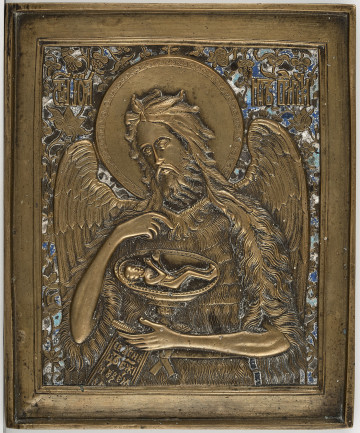
St. John the Baptist
20th century
Castle Museum in Łańcut
Part of the collection: Icons
Crucifixion - staurotheke Found in Jerusalem in 326 by Empress Helena and the Patriarch Macarius of Jerusalem, the wood from the True Cross became one of the greatest Christian sacred objects. Relics, i.e., particularly revered sacred objects and remains, are stored in special containers called reliquaries. One of the three fragments of the wood from the True Cross, brought by Empress Helena to Constantinople, was placed in the Church of Hagia Sophia. In Byzantium, as well as in the lands of Rus, relics and miraculous paintings were sheltered in chest-like containers, known as 'kovchegs' ('kovcheshes') or 'kiots' ('kivots') from Greek. Reliquaries containing fragments of the True Cross were called ‘staurothekes’. The Greek term combines two words: 'stauros', meaning 'beam' (of a cross) and 'theke', meaning 'frame', 'container'. Usually, the parts of the True Cross were affixed to a crucifix placed in a richly crafted container, decorated in a way that alluded to the holy object stored inside. Over time, the term 'staurotheke' started being used for the icons depicting the Crucifixion which had a separately crafted metal or wooden cross placed inside a hollowed-out area of the same shape in the wooden canvas board. The displayed icon is an example of a staurotheke defined in this way. In it, crucified Christ, in the presence of the Lord's Legions shown above him - Yahweh Saboath and the Holy Spirit in the form of a dove - painted on a separate, cross-shaped silhouette icon, is revered by three women (the Mother of God, Mary of Clopas, and Mary Magdalene), as well as John the Baptist and the centurion Longinus. In the scene set against the background of Jerusalem, the two thieves crucified alongside Jesus on Golgotha were also painted. The dark sky on the icon clearly indicates the moment of the solar eclipse described in the Gospels, which occurred before the death of the Saviour (Matthew 27:45; Mark 15:33; Luke 23:45). Teresa Bagińska-Żurawska https://orcid.org/0000-0002-9243-3967
Dimensions
height: 62 cm, width: 51 cm
Object type
Icons
Technique
gilding, tempera
Material
gold, tempera, wood
Origin / acquisition method
decyzja administracyjna
Creation time / dating
Creation / finding place
Owner
Castle Museum in Łańcut
Identification number
Location / status

20th century
Castle Museum in Łańcut

19th (?) century
Castle Museum in Łańcut

1800 — 1850
Castle Museum in Łańcut
DISCOVER this TOPIC
National Museum in Lublin
DISCOVER this PATH
Educational path